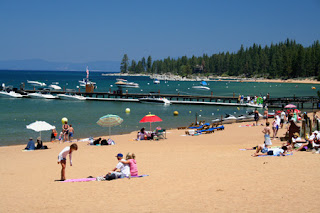We've all noticed
that when you drive from the valley up into the mountains it cools
off. (Which is why Tahoe is so popular in August when it hits triple
digits in Sacramento.)
Why is this?
The simple
only-kind-of-techy answer is that the lower you are the more
atmosphere is above you, and the more the air gets squeezed by all
the air above it. The molecules in compressed air have more energy
and they bounce around faster than they do in air that isn't so
compressed.
Lucky for us, we
have sensors in our skin that can take a reading on how fast those
molecules are hitting us. We call it temperature. It's a
self-protective measure, because if those molecules hit us too fast,
we cook. And if they hit us too slow, we freeze.
 |
| (From the Orange County Register) |
Okay, that's
simplified.
What I really
wanted to know is this: Is there a regular amount that temperature
rises or falls when you go down the mountain or up the mountain?
So I did a little
Wikipedia research.
First thing I
noticed was that this is a regular subject (Who knew?), and it's
called the Temperature Lapse Rate.
Turns out that the
answer is yes, the temp fluctuates with elevation change in a regular
manner. How much?
Well, as always
there is a complication or two, and they involve how humid the air is
and how much it is moving. But I learned that there is a range that
we can count on.
If the air is
really dry, the temps will cool a bit over 5 degrees Fahrenheit for
each thousand feet you go up.
And if the air is
really humid, the temps will cool a bit less than 3 degrees for each
thousand feet you go up.
I had to pause at
that point and think about the air around Tahoe. Usually it is quite
dry except when we get storms. So I decided there was nothing wrong
with taking an average.
Average "less-than-3" with "more-than-5" and you get a nice round 4.
So there's my
answer. On average, the temp goes up or down about 4 degrees for
every thousand feet of elevation loss or gain.
Let's say I'm at Donner Summit, a bit over 7000 feet above sea level. It's January 6th, and the temperature is
a chilly 25 degrees. What's the temp in the Central Valley? Because
the Central Valley is close to sea level, I'll lose approximately
7000 feet. 7 (for seven thousand feet) times 4
degrees equals 28 degrees. So Sacramento is probably a comfortable 53
degrees (28 plus 25).
Play the game in
reverse: How much can a broiling Sacto resident expect to cool off
when it is 105 degrees downtown in August? This time, let's ignore the summit,
because most people don't vacation on the pass. They head on in to
Tahoe at 6300 feet. Again, rounding, 6 (for six thousand feet) times
4 degrees is 24 degrees. So when Sac is 105, Tahoe is going to be 24
degrees cooler, or a pleasant 81.
Of course, the
cold lake cools things off more, so we're probably more like 77
degrees.
Now we know why
Tahoe gets crowded in the summer!



No comments:
Post a Comment